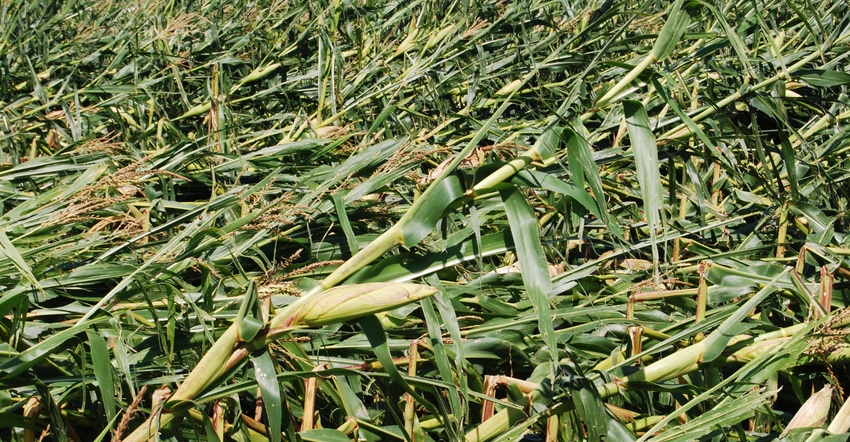September 3, 2020

Agriculture Secretary Sonny Perdue has designated 18 Iowa counties as primary natural disaster areas, enabling producers who suffered losses because of the derecho that occurred on Aug. 10, 2020, to be eligible for emergency loans.
The counties declared natural disaster areas: Benton, Boone, Cedar, Clinton, Dallas, Guthrie, Hamilton, Hardin, Jasper, Johnson, Jones, Linn, Marshall, Polk, Poweshiek, Scott, Story and Tama.
Additionally, Perdue reminds producers of disaster assistance programs available through USDA, including program flexibilities and a special signup through the Environmental Quality Incentives Program.
“The extent of damage to crops, equipment, facilities, and the ag sector as a whole from this storm is devastating,” Perdue said. “The recovery process is in full swing, and USDA is working diligently to expedite financial and technical support for Iowa farmers and livestock producers who have suffered unprecedented losses. We are standing by to expand this designation as we learn more about the full impacts of the derecho.”
Emergency Loans
These natural disaster designations allow the Farm Service Agency to extend much-needed emergency credit to producers recovering from natural disasters. Emergency loans can be used to meet various recovery needs, including the replacement of essential items such as equipment or livestock, reorganization of a farming operation, or the refinancing of certain debts.
Contiguous Designation
In addition to the 18 Iowa counties listed above, producers in the contiguous counties listed below are also eligible to apply for emergency loans:
Iowa: Adair, Audubon, Black Hawk, Buchanan, Butler, Carroll, Cass, Delaware, Dubuque, Franklin, Greene, Grundy, Iowa, Jackson, Keokuk, Louisa, Madison, Mahaska, Marion, Muscatine, Warren, Washington, Webster, and Wright.
Illinois: Carroll, Rock Island, and Whiteside.
The deadline to apply for these emergency loans is May 3, 2021.
FSA will review the loans based on the extent of losses, security available, and repayment ability.
Flexibilities on Environmental Compliance Reviews
To assist producers in Iowa, Illinois, Indiana, Ohio, and other states impacted by the derecho, FSA has streamlined the environmental compliance review process for the Emergency Conservation Program, Emergency Forest Restoration Program, Emergency Loan Program, Farm Storage Facility Program, and Tree Assistance Program. Implementation of these programs has been determined to have potentially low impact to protected resources.
These program flexibilities are meant to address work required to restore existing crops, fields, orchards, barns, storage facilities, fences, equipment, and general debris removal. Work required on previously undisturbed ground, new land clearing, or work that would impact any water body, wetland, riparian buffer, or wetland would not be covered by the streamlined environmental review process.
EQIP Special Signup
Additionally, USDA’s Natural Resources Conservation Service is making available $4 million in recovery assistance through a special EQIP signup in parts of Iowa impacted by the derecho. Applications will be accepted through Oct. 2, 2020. Eligible applicants will receive higher than normal EQIP practice payments rates during this signup.
These EQIP funds can be used for:
Seeding cover crops on impacted fields;
Replacing roofs, covers, or roof runoff structures previously funded through NRCS; and
Replacing damaged high tunnel systems previously funded by NRCS.
More Information
In addition to emergency loans and EQIP, other available programs include the Emergency Assistance for Livestock, Honeybees and Farm-Raised Fish Program; Emergency Conservation Program, Livestock Forage Disaster Program, Livestock Indemnity Program, and Operating and Farm Ownership Loans. These programs and other available recovery assistance do not require a disaster designation.
Producers and landowners can use the online Disaster Assistance Discovery Tool, answering five questions to identify USDA programs that will help meet disaster recovery needs.
For more information on all USDA disaster assistance programs, visit farmers.gov/recover, or contact your local USDA Service Center, which can be found at farmers.gov/service-center-locator. For assistance with a crop insurance claim, please contact your crop insurance agent.
Source: USDA, which is solely responsible for the information provided and is wholly owned by the source. Informa Business Media and all its subsidiaries are not responsible for any of the content contained in this information asset.
You May Also Like




